by Dr Rob Liddiard, University of East Anglia
During the Second World War, Dunwich Heath was one of the heaviest defended parts of the Suffolk coastline with a radar station, coastal artillery battery and anti-invasion defences. Later in the war, the heath was an important training ground. Systemic clearance after the war means that only a small amount of the wartime archaeology now remains.
Radar Station
Image: Aerial photograph from 1949 showing the radar station and battery on Dunwich cliff (Stuart Bacon, Suffolk Underwater Studies)
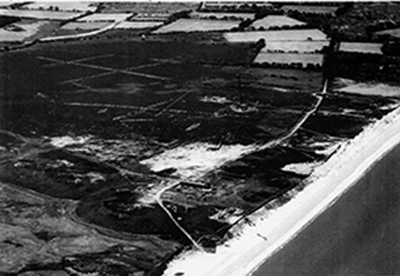
Although almost nothing remains above ground to be seen today, Dunwich was the site of a radar station that was a vital link in the chain of Britain’s air defence system during the war. Dunwich was a number of Chain Home Low (CHL) radar stations designed to give early warning of low flying enemy aircraft. Dunwich became operational on New Year’s Day 1940 and initially was fairly rudimentary, comprising two 20ft gantries (one receiver and one transmitter), with timber huts for equipment below. Over the winter of 1940–41, a replacement CHL was built slightly to the west, which became operational on 15th February 1941. This conformed to a standard design, with an operations building and a single 20ft gantry and powered by mains electricity.
Continual experiments were made to the CHL system in order to improve performance against the wave-skimming approaches by German aircraft attempting to avoid the radar screen. One method that gave better results was to raise the aerial onto a 185ft tower. Dunwich was one of five places to become a CHL ‘Tower’ station and was chosen because it was in an area where low-flying raiders were common. The new station became fully operational with its new equipment in the spring of 1943. The station was dismantled in the 1960s and there is almost nothing left to see today; it has all fallen into the sea or been removed, but occasionally erosion reveals parts of the former buildings.
Emergency Coastal Defence Battery
Image: Staged propoganda photograph taken from inside the right hand gunhouse of the Minsmere battery, 1941.
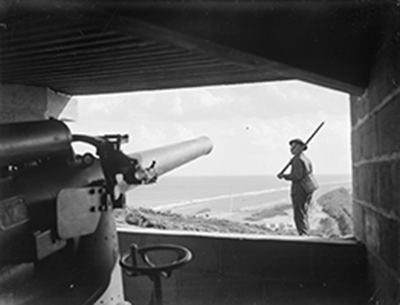
In 1940 and 1941 batteries of coastal artillery were placed at vulnerable points along Britain’s coastline in order to bombard enemy shipping taking part in any invasion attempt. This ‘Emergency Coastal Defence Battery’ programme saw guns taken from ex-Royal Navy vessels scrapped after the First World War and subsequently put into storage, brought back into service. In May 1941 a battery was built on the cliffs at Dunwich comprising two six-inch guns in concrete gun houses. It was operational for nearly two years before the gun and other equipment were moved to Landguard Fort at Felixstowe.
The battery observation post, now known as the lookout, was built onto the end of the existing row of coastguard cottages both to give an excellent view out to sea and also in order to conceal its true purpose from German reconnaissance. The only other part of the battery to survive is the generator building, complete with loopholed walls for close defence, which today is also used as an observation platform.
Anti-Invasion Defences
Image: Spigot mortar pedestal under excavation with a modern replica mounted in place (National Trust)
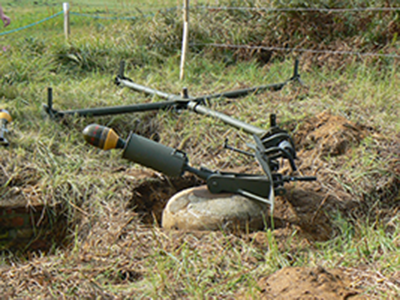
With a radar station and a coastal battery to protect, Dunwich heath was covered with infantry positions and defences. Only one of these survives today, the spigot mortar pedestal that lies concealed in the heather. The spigot mortar was a weapon that fired a 20lb projectile that could be used against infantry or armoured vehicles. When used in a static role, a surrounding pit was dug for the crew of three to five men, which was reinforced with concrete and provided lockers for the ammunition. Traces of this structure have been found by excavation here at Dunwich. The spigot mortar post was combined with other defences that have since gone, such as concrete pillboxes, trenches, anti-tank blocks and barbed wire. These defended both the battery and the radar station. On the heath itself, anti-landing and anti-tank ditches were also dug to protect the cliff from German troops who had landed elsewhere and who were expected to attack from the west.
In 1944 the final defences to be built were for a ‘Diver’ battery of anti-aircraft guns that was located on the cliff with the task of shooting down V1 rockets that were fired from German aircraft operating over the North Sea.
Training
Dunwich Heath was part of what was known as the Dunwich training area, which was established early in the war. Throughout the conflict, hundreds of troops and tanks used the heath for training purposes as live firing could be carried out without hindrance. The Dunwich training area was particularly important in pre-D-Day training. In 1943, it was the setting for exercise ‘Kruschen’, which was one of the first exercises to trial the specialised equipment that would be needed to break the concrete defences of the German Atlantic Wall.

Image: Painting by war artist Edward Bawden of Exercise 'Kruschen' showing a man practicing with a flame-thrower on the heath in 1943 (Imperial War Museum IWM Art LD 2890)
Post-War Clearance
Image: An Army Bomb Disposal team clearing ordnance during the 1960s (National Trust).

Given all the military activity on the heath it is surprising that so little remains to be seen today. During the 1960s a major heath fire caused large quantities of unexploded ordnance to be detonated and so a decision was taken to systematically clear the area of its Second World War remains. The wartime defence structures were also removed as the concrete was then in demand as hardcore for construction projects.
As a result, only a small percentage of the wartime archaeology remains to be seen today.

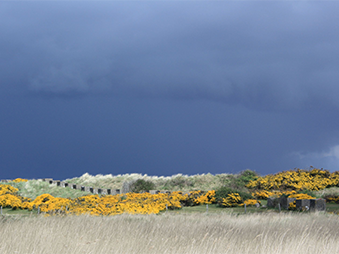
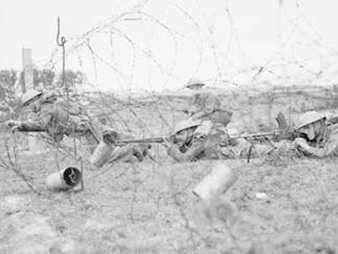
Second World War Guidebooks
a series of four guidebooks to Suffolk's Second World War archaeology
Discover More »